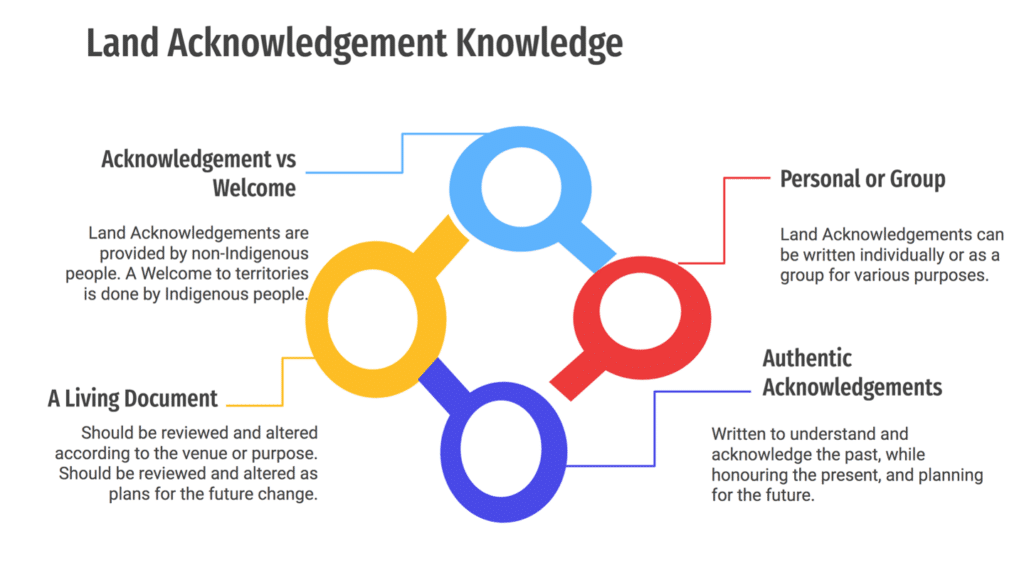Instructions:
- To begin, the teacher can show students a Pre-Contact Map that includes the pre-contact location of Indigenous groups on Turtle Island from time immemorial.
- Teachers can then discuss the process of colonization and local treaties significant to this area.
- The teacher can then ask students what they know about land acknowledgements and why they think they are (or are not) important.
- Next, the teacher can show students the following video depicting the importance of land acknowledgements: Territorial Acknowledgements: Going Beyond the Script: https://www.youtube.com/watch?v=yXYhBml2c2I
- Teachers can then lead students through PPT found in Land Acknowledgement Creation. See the content found in PPT below.
PPT content:
Importance of Land Acknowledgements
Chances are, you’ve seen or heard a land acknowledgement at some point in the past few years. But maybe you don’t totally understand why land acknowledgements are so important.
They are not about placing blame.
Land acknowledgments are about our collective connection to and relationship with the land. Indigenous people’s connection to the land is sacred and foundational to their ways of knowing and being and the land acknowledgement is a way of reminding everyone of this. Historically, when communities would come together to a particular area, the visitors would acknowledge the inhabitants/keepers of the land. It was to show respect.
So, the land acknowledgement is also about showing respect for the traditional keepers of the land – the original Indigenous inhabitants. It is a way of recognizing inherent rights to the land that First Peoples hold. It is also a way of recognizing the injustices that have been carried out against Indigenous communities historically, for example, through broken treaty relationships, residential schools, the Sixties Scoop.
Acknowledgement of the traditional territory upon which we all live is an important step toward reconciliation. It is one of the recommendations or “calls for action” put forward by the Truth and Reconciliation Commission of Canada to help restore a balanced relationship between Indigenous peoples and settler communities.
Unfortunately, in recent years land acknowledgements have come to commonly be recited at the beginning of events with little thought to their intended purpose. When used in this manner land acknowledgements can appear as a box to check as opposed to a meaningful statement reminding Canadians of their collective relationship to one another and with the land. It is important that when land acknowledgements are used, they are utilized in a meaningful way reflecting the relationship the individual who is delivering the acknowledgement has to the traditional territory and its original inhabitants. This can be done by reflecting on and stating what they are doing not only to live as allies working towards reconciliation but also to live in reciprocity with the land, protecting it for the next 7 Generations. An important takeaway is that colonization severely eroded the relationship of reciprocity Indigenous communities enjoyed with the natural world. Restoring this relationship of reciprocity for all Canadians, accordingly, is a powerful act of reconciliation and decolonization.
- Teachers then discuss with students the qualities of a good land acknowledgement and things to consider by looking at and discussing the following graphic.

- Students watch the following video as an exemplar of a meaningful land acknowledgement: Land Acknowledgements: Uncovering an Oral History of Tkaronto: https://www.youtube.com/watch?v=voXySM-knRc
- Teachers discuss with students ways in which the process of reciting land acknowledgements can be made more meaningful. As mentioned above, it is important to reflect on what we are doing in our daily lives (beyond our land acknowledgement) to contribute to reconciliation.
- Students practice writing their own land-acknowledgement.
Extension: Holism and Interdependence
- Using the worksheet in Holism and Interdependence.pdf the teacher can run through an activity that teaches the ideology of interconnectedness and holism. In the activity, students are each given a ball of yarn and asked to wrap it around objects they are connected to (it is OK if participants’ yarns overlaps with one another’s). The point of this activity is to show how humans are interconnected with all biotic and abiotic elements in the natural world. This activity reminds us of the relationship of reciprocity with the land disrupted by colonization.



